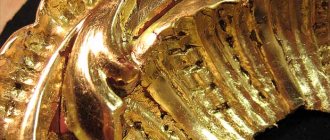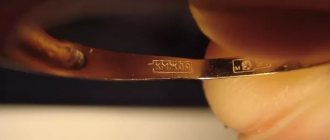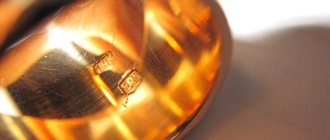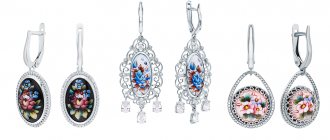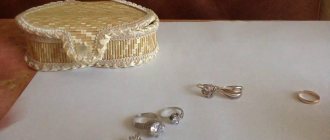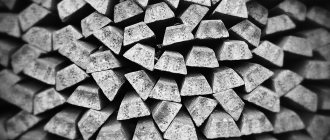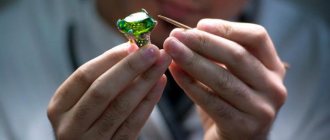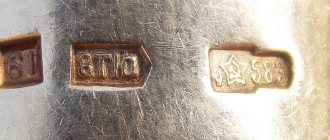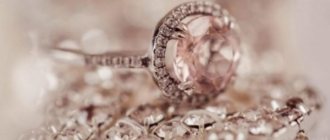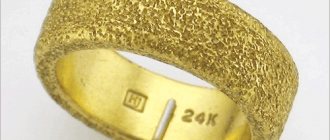Post updated: May 25, 2020
Products made from gold alloys of various grades are used not only as jewelry; parts made from precious metals are also actively used in industry. The use of pure gold in these cases is usually not economically justified; most often, only an external gold coating is required, which gives the element the necessary properties. Surface gilding is one of the main galvanic processes in jewelry, which allows giving the product the required decorative or technical characteristics. How is electroplated gold produced?
Gold plated jewelry
When they hear the word “jewelry,” many fashionistas imagine unremarkable plastic or metal jewelry that carries no value. High-quality costume jewelry cannot be classified as this type of product; even its base is made of cheap material. Craftsmen usually use base metals for the base of jewelry, and to give it an attractive appearance, they apply a beautiful coating using the galvanic method.
Cupronickel, bronze, brass, pewter or nickel silver are used to produce blanks for jewelry. All these alloys differ from each other in color characteristics and properties. Cupronickel is produced by alloying copper, iron, nickel and manganese. The result is an alloy similar in color to silver. Pewter is made from tin, which makes it easy to cast. Nickel silver is an alloy of zinc, nickel and copper, which, depending on the predominant element, acquires a tint of different shades. Bronze and brass contain copper, which makes their color quite attractive.
Craftsmen achieve the golden color and characteristic “precious” shine using electroplating. The base of the decoration does not have to be metal; it can also be a material of a non-metallic nature. During the galvanic process, the product is coated with a layer of gold or silver. In recent years, the rhodium procedure has often been resorted to.
Electroplating with gold provides the decoration with an attractive appearance. Reviews of such products are divided into two parts. Lovers of good jewelry speak positively, arguing that gold-plated jewelry has the effect of a precious metal, but for less money. High-quality coating and painstaking work of an experienced craftsman can bring the most daring design ideas to life. Others have a negative attitude towards products of this kind, since they only recognize precious jewelry.
What products are gold plated and why?
The galvanic method of gilding surfaces has found application in various fields. This technology allows you to decorate the product and provides technical coating in industry. Objects, jewelry, technical parts coated with gold do not oxidize, do not collapse, and are resistant to the aggressive effects of various substances.
Electroplating has found wide application in the manufacture of inexpensive jewelry, which is especially popular among buyers of both sexes. When making gilded items, items are taken from cheaper materials, which are then coated with a thin layer of gold. As a result, such products can be purchased at a better price, and they look no worse than gold ones. Electroplating is used for gilding chains, bracelets, earrings, rings, watches, necklaces and even glasses. The items look very respectable, stylish and elegant.
An interesting feature: in the post-Soviet space, yellow-red gilding is in great demand among the population, and in America and European countries - a pale yellow tint. Typically, products are taken as a basis: copper, cupronickel, nickel or brass. Electroplating is also used to gild platinum and silver. Jewelry treated in this way does not cause irritation or allergic reactions. However, sometimes these jewelry can compete in price with items made from high-grade silver.
Sometimes jewelry or items are only partially covered. This is done in order to impart the necessary properties of gold to a separate area of the surface. In the jewelry industry, this is how jewelry is given an original and unique design.
Electroplating is used in many fields. It can be applied to almost any thing, improving its characteristics and properties. Gold leaf is used to cover the domes of churches and temples, as decoration for expensive household items, beautiful dishes, and baguettes.
Methods of applying gold plating
Among the possible options for applying gilding, experts distinguish two methods: mechanical and electrochemical. The mechanical method involves covering the surface with gold leaf. Gilding with the thinnest sheets of metal has been used since ancient times; over many centuries, the essence of the procedure has remained virtually unchanged. Gold leaf plating can be oil-based or glue-based; in the first case, the metal is glued to oil varnish, and in the second, to polyment. The oil-based coating turns out matte; to achieve the effect of a shiny surface, experts resort to using an adhesive base. Work on creating an adhesive coating can be carried out exclusively indoors, since such gilding is characterized by high sensitivity to moisture.
The electrochemical version of surface treatment with precious metal is a galvanic method of applying gold to a product. What it is? During the work, the master applies, using electric current, a thin layer of yellow precious metal, the size of which can reach fractions of microns.
Like any coating, electroplating has its advantages and disadvantages over other options. There are quite a few advantages of coating obtained in this way. These include a high level of wear resistance, excellent reflectivity, high current conductivity, the ability to protect the product from aggressive external factors, the effects of corrosive and oxidative processes. When applying galvanic coating, the specialist carrying out the work can control the thickness of the precious metal layer. Due to the listed properties, galvanic gilding is widely used both in surface decoration and for creating technical parts of devices.
Electrochemical deposition of gold on the surface.
For a long time, the main disadvantage of the method was considered to be the limited scope of its application. The electrochemical method of applying gold to a surface assumes that this surface is conductive, that is, made of metal. Thanks to scientific advances, this problem has now been partially resolved: special technologies make it possible to gild dielectric materials using conductive varnishes and films.
Gilding technology
Gold plating is a process of depositing a metal film. The thickness of the film can be different; depending on the purpose of gilding, a specialist can apply a layer on the product with a thickness ranging from a fraction of a micron to a fraction of a millimeter. The whole process is divided into three stages: first the surface must be prepared, then a layer of metal is applied and final processing is carried out.
A high-quality coating will only be achieved if the surface to be treated is well prepared. The product is pre-polished mechanically. To do this, use sandpaper, special pastes or grinding machines. Then the surface is degreased in an organic solvent. Alcohol, acetone or gasoline can cope with this task. Another mandatory procedure before galvanic treatment is pickling - removing existing contaminants, oxides and rust from the surface.
Sometimes it is necessary to electroplate only part of a part; for this, the remaining areas of the product must be protected from the effects of electrolyte and gold deposition. To do this, before applying the precious coating, acid-resistant varnish is applied to areas that are not subject to gilding.
The part is plated with gold using galvanic baths. The work is carried out using conductive suspensions and drums made of acid-resistant materials or in bell installations that ensure excellent electrical contact. The galvanic bath must also have an acid-resistant coating so as not to be destroyed under the influence of the electrolyte and equipment in the form of steam jackets. The entire process takes place at high temperature and the required current density, which are supported by automatic regulators. It is almost impossible to carry out galvanic procedures at home, since this requires not only special equipment, but also rare chemical reagents.
Upon completion of the work, the product is coated with a thin metal layer, which provides the best characteristics for the part. For decorative products, it is important to acquire an attractive appearance and the desired shade, for industrial parts - the ability to resist corrosion, improve electrical contact and facilitate the soldering process. Sometimes galvanic coating is used to increase the volume of a product. Depending on what properties need to be imparted to the part, electroplating can be done with both gold and other elements: silver, chromium, nickel.
Applying gold plating at home
To gild objects at home, chemical and galvanic methods are used. Many reagents and reagents cannot be purchased freely. These include nitric acid, potassium cyanide and hydrochloric acid. For home gilding, you must have electrolytic baths, as well as a source of constant electricity. A master engaged in electroplating must have theoretical knowledge, dexterity and experience. Caution and patience must be exercised as this is a dangerous process.
Chemical methods
Gold chloride is applied to the surface to be treated. Method one. To prepare gold chloride, the metal is forged into a thin layer and crushed into very small pieces. Then hydrochloric and nitric acid are mixed, and only then gold is added to them. A mixture of two acids is often called aqua regia. Aqua regia is prepared as follows: 10 g of concentrated nitric acid is mixed with 30 g of hydrochloric acid. The amount of “golden mixture” is prepared in a ratio of ten to one. That is, for one gram of gold there is 10 ml of a mixture of acids (aqua regia).
For the dissolution process, deep porcelain dishes are taken. The time it will take varies: two hours or three days. After the gold has completely dissolved, the mixture is evaporated using a water bath at a temperature of 70–80˚, stirring thoroughly with a glass rod. At the end of evaporation, a viscous golden-colored substance should appear.
To prepare the mixture you need to take:
- two liters of distilled water, heated to 50–60˚;
- 15 g of gold chlorine salt syrup;
- 65 g of “Extra” salt, which is highly purified sodium chloride;
- 65 g of potash - potassium carbonate.
Before starting to coat the product, the surface is degreased using 10–20% sodium hydroxide. If the item is small, you can boil it in a soda solution. Then the surface is treated with a 25% solution of hydrochloric acid and rinsed in water.
The next step is preparing a mixture that includes potash, gold chloride, hot water and sodium chloride. The product is immersed in a container with this solution and touched with a zinc stick. They wait a certain amount of time and pull the already gilded product to the surface. It is thoroughly washed in clean water, dried and brought to a mirror shine.
Method two. Prepare a special solution:
- water – 25 g;
- hydrochloric acid and nitric acid - 25 g each.
10 g of gold is dissolved in this composition. 300 g of potassium carbonate (potash) is added to the resulting mass. Next, boil 2 liters of water in a cauldron and pour the prepared mixture into it. Stirring occasionally, “cook” it all for two hours.
While the mixture is being prepared, the product is being processed. It is etched with sulfuric acid and then with nitric acid. Then a series of actions are performed, in particular, they wrap the product with brass wire (an alloy of copper and zinc), make a mixture of hydrochloric, nitric and sulfuric acid and immerse the product being processed in it, literally for a short moment. Next, rinse the object in water and immerse it in mercury, and then again in water, then immerse it in the already prepared mixture. After everything is taken out, washed and dried. The dried product must be polished using a wool cloth.
Paste rubbing method
This method differs from chemical and galvanic processing of an object. Its essence boils down to the production of a special paste, which is then applied to an object or part. The gold layer is thinner.
To prepare 100 g of pasta you need to take:
- 30 g potassium hexacyanoferrate (yellow blood salt);
- 10 g of gold chloride;
- 5 g cremortartar;
- 55 g chalk powder.
The mixture must be diluted with water until a mushy mass is obtained. The product is degreased and rubbed with the resulting mixture.
Galvanic method
There are two main ways. First: you need to prepare three solutions:
- 60 g sodium phosphate and 700 g clean water;
- 2.5 g of gold chloride and 150 g of water;
- 150 g water, 1 g potassium cyanide and 10 g sodium sulfate.
First, the first two solutions are mixed. Then a third one is added to them. The temperature is kept between 50-60 degrees. The anode must be made of platinum. When the electrolyte mixture is depleted, gold chloride is added.
Second method: Zelmi bath. Take 1 g of sodium carbonate and 1 g of potassium hexacyanoferrate and mix with water (30 g). The resulting mixture is heated in a porcelain bowl. Next, you need to add gold precipitated with ammonia to the resulting mass. All this is boiled for 10–12 minutes. Water is constantly added as it evaporates. A current is then passed through the resulting solution. Processing time 15–16 hours.
Useful tips
When gilding jewelry with your own hands, these recommendations will come in handy.
- To gild an iron or steel surface, gold chloride syrup is dissolved in ether. The prepared mixture is applied to woolen fabric and objects are treated with it. The ether should disappear, but the gold should remain.
- Zinc, iron, tin and steel items are pre-coated with copper. In this case, the gold lies in a more even layer.
- At home, the gilding process requires special conditions. The chemical method or rubbing is simpler and more convenient. Gold plating is not a very expensive method, but it can turn an inexpensive product into a noble and sophisticated decoration.
The galvanization method has a number of advantages, including the ability to give an item a rich and luxurious look, improve the quality of the product, and improve its characteristics and properties. This surface coating also protects against destruction and environmental influences.
Gold alloy plating
To coat products, gold alloys are most often used, to which a ligating component is added. An additional element in the alloy allows you to give the part the necessary qualities and the desired shade. In Russia, preference is given to gold with a reddish tint; in the USA and some other countries, priority is given to coatings of lemon yellow or brass shades.
In order for electroplating to have a tint not like gold, but like platinum, the working alloy must consist of gold and nickel, the percentage of which must be at least 8-10%. This coating will have a white tint and will also be highly hard compared to a pure gold layer. The higher the proportion of nickel in the alloy, the higher the hardness and wear resistance of the final surface will be. Electroplating based on gold and nickel is used abroad for jewelry. Due to their high resistance to corrosion processes, they can also be used for technical purposes.
An alloy of gold and copper is used in Russia to coat elements of wristwatches. The progress of the process depends on the concentration of free cyanide in the electrolyte: the higher the concentration of the substance in the electrolyte, the lower the copper content in the resulting coating. When the process is carried out under conditions of neutral electrolytes, a copper-gold coating with a thickness of 20 microns can be obtained.
In addition to the listed alloys, gold-silver and gold-antimony compositions are also used. The percentage of elements in the final coating depends on the characteristics of the electrolyte and the chemical reagents used.
Gold-antimony electroplating has earned positive reviews for its use in gilding eyeglass frames. A coating of this composition is characterized not only by increased wear resistance, but also by an attractive appearance. Depending on the thickness, it can turn out semi-shiny or shiny. Such properties, together with a high level of resistance to mechanical stress, allow the alloy to be used for decorative purposes.
